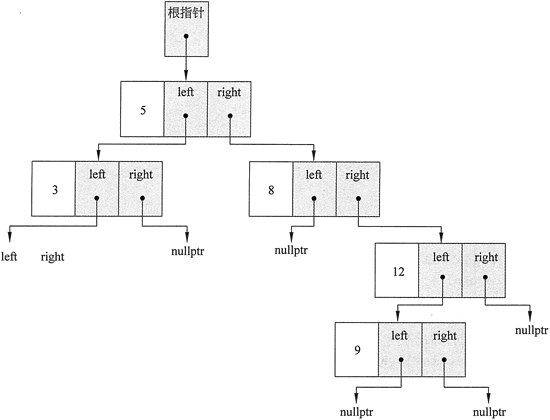二元搜尋樹基本操作詳解
2020-07-16 10:04:42
建立二元搜尋樹
現在使用 IntBinaryTree 類來演示基本的二元樹操作。在本範例中,二元樹結點的基礎是下面的類宣告:class TreeNode
{
int value;
TreeNode *left;
TreeNode *right;
TreeNode(int value1,TreeNode *left1 = nullptr,TreeNode *right1 = nullptr)
{
value = value1;
left = left1;
right = right1;
}
};
請注意,樹的每個結點都有一個 value 成員,另外還有兩個指標,用於跟蹤結點的左側和右側子結點。這個類只能被 IntBinaryTree 的方法使用。//IntBinaryTree.h的內容
class IntBinaryTree
{
private:
//The TreeNode struct is used to build the tree.
struct TreeNode
{
int value;
TreeNode *left;
TreeNode *right;
TreeNode(int value1,TreeNode *left1 = nullptr,TreeNode *right1 = nullptr)
{
value = value1;
left = left1;
right = right1;
}
};
TreeNode *root; // Pointer to the root of the tree
// Various helper member functions.
void insert(TreeNode *&, int);
void destroySubtree(TreeNode *);
void remove(TreeNode *&, int);
void makeDeletion(TreeNode *&);
void displayInOrder(TreeNode *) const;
void displayPreOrder(TreeNode *) const;
void displayPostOrder(TreeNode *) const;
public:
// These member functions are the public interface.
IntBinaryTree。 // Constructor
{
root = nullptr;
}
~IntBinaryTree() // Destructor
{
destroySubtree(root);
}
void insert(int num)
{
insert (root, num);
}
bool search(int) const;
void remove(int num)
{
remove(root, num);
}
void showInOrder(void) const
{
displayInOrder(root);
}
void showPreOrder() const
{
displayPreOrder(root);
}
void showPostOrder() const
{
displayPostOrder(root);
}
}
除了 TreeNode 類宣告之外,該類還有一個 root 成員。這是一個指向二元樹根結點的指標,起著類似於連結串列中 head 指標的作用。在許多情況下,將指向二元樹根結點的指標視為二元樹本身是很有用的。因此,可以寫作如下形式:
TreeNode *tree;
或
TreeNode *root;
IntBinaryTree Tree;
為了避免混淆,當使用由 IntBinaryTree 類的物件表示二元樹時,該二元樹的識別符號首字母釆用大寫形式,例如 "IntBinaryTreeTree;";當使用由指向其根結點的指標表示二元樹時,則該二元樹的識別符號首字母釆用小寫形式,例如 "TreeNode *root;"。IntBinaryTree 的公共成員函數包括:建構函式、解構函式、用於在樹中插入新數位的成員函數、用於搜尋樹以確定給定的數位是否在樹中的成員函數、用於從樹中移除數位的成員函數,以及根據不同的順序顯示儲存在樹中的數位的成員函數。
下面的程式演示了建立一個 IntBinaryTree 物件和使用公共 insert 成員函數來構建一個二元搜尋樹:
// This program builds a binary tree with 5 nodes.
#include <iostream>
#include "IntBinaryTree.h"
using namespace std;
int main()
{
IntBinaryTree tree;
cout << "Inserting numbers. ";
tree.insert (5);
tree.insert(8);
tree.insert (3);
tree.insert(12);
tree.insert (9);
cout << "Done. n";
return 0;
}
程式執行結果如圖 1 所示:

圖 1 使用 insert 成員函數構建的二元樹